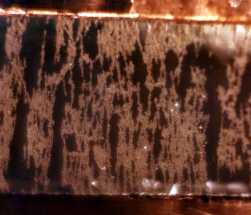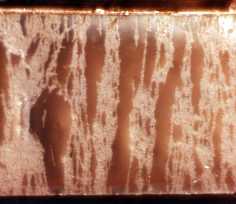


Electrorheology
My interest in Electrorheological (ER) fluids was stimulated by a short spell working at GEC. Moving on to a temporary lectureship at Manchester a simulation of these fluids provided a timely and novel piece of simulation work (see abstract).
ER fluids are characterized by a significant change in rheology under the influence of a large electric field. These fluids are normally Newtonian (or nearly!) like any other dispersion but a field of > 1 MV m-1 changes them into gels with a yield stress of some kPa. This means that in effect they become somewhat solid in character.



An ER fluid that supports its own weight between two electrodes when a field (~1 MV m-1) is applied reliquifies when the field is turned off.
The exact mechanism for this change is still debated. Although some liquid crystalline fluids can respond in this way the majority of ER fluids to date that show a significant effect are dispersions of polarizable particles in fluids of low conductivity. These can be as simple as starch dispersed in transformer oil for example. Particle based ER fluids invariably show a "fibrillated" structure when dilute dispersions are viewed under the microscope.


Two examples of fibrillation in a dilute (~2%) ER fluid under an electric field 2 MV m-1. The separation between electrodes is about 0.5 mm.
The alignment of particles demonstrates that an increased field-oriented force exists between the particles and polarization of the particles is a clear candidate. But electrostatic polarization alone is insufficient to account for the large rheological changes observed (in particular the high yield stresses attained) and part of the polarization appears to be due to current flow (see abstract). Note that for practical usage ER fluids with much higher particle volume fractions of ~30% are necessary to generate the large rheological changes needed. In these systems the structure of the fluid under a field and shear flow is difficult to ascertain experimentally. Computer simulations were first to predict the alignment of sheets of particles orthogonal to the flow (see abstract): a feature which has since been observed experimentally.
There are a number of potential engineering applications for ER fluids but, so far, they have not been sufficiently competitive with alternative solutions to be commercially viable.
Later work at Sheffield as part of the SMMART team with W.A.Bullough I studied engineering aspects of these fluids applied to clutches and valves. Practical ER fluids need to develop a high yield stress and they need a short response time to be competitive with other mechanical devices. This engineering imperative provides an interesting contrast to the physicists approach to ER fluids who, for their purposes (easy to probe with light, linear, etc), often study impractical systems with low particle concentrations. The theoretical link between particle conductivity and rheological behaviour was also probed (see abstract). Conductivity had not always been recognized as important in ER behaviour most authors discussing only the dielectric response. This paper related the polarization time to the rheological response time – an important feature for practical ER fluids.
ER fluids are currently out of favour but the work described here also applied to Magnetorheological fluids which are mathematically equivalent.
Abstracts:
Home Chemoinformatics Group Dept. of Information Studies University of Sheffield